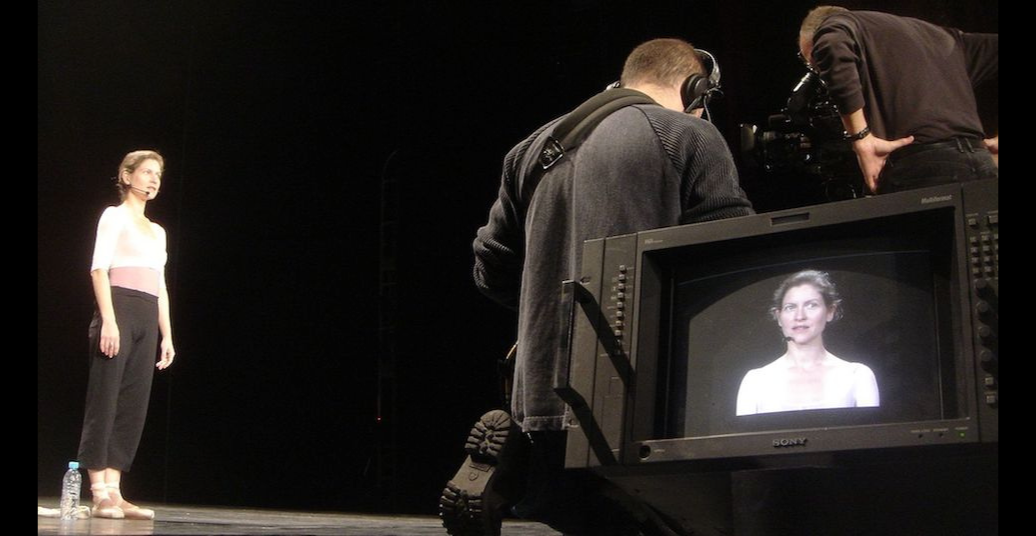In his choreographic self-portrait “Jérôme Bel / Ruth Rosenfeld,” which was shown on 23 January 2023 in HAU2, the established choreographer carries out a thorough and somewhat unsatisfying revision of his oeuvre to date.
The expectations have been set high: an “‘auto-bio-choreo-graphic’ performance that stretches back to his beginnings and lays bare doubts, commitments, failures, and passions,” is how the playbill describes Jérôme Bel’s solo lecture-performance, named after himself. Part of the work’s concept is a casting change for each location in which it is performed. In Berlin, the choreograph is played by Schaubühne actor Ruth Rosenfeld, whose name misleadingly also appears in the title of the piece — misleading because she simply lends her body, her voice, and her movements to the performance, an avatar without history or identity. On the other hand, the title references from the very beginning a tendency that has become increasingly insistent in the megastar of conceptual dance’s more recent works: the adamant disinterest in the inadequacies of representation.
“My name is Jérôme Bel,” Rosenfeld says to the audience at the beginning of the performance, and in the almost two hours that follow, narrates the choreographer’s career in Bel’s usual brief and conversational manner. For most of this telling, she sits on the edge of the stage in front of two laptops from which she reads the text aloud and plays archival material from nearly 30 years of artistic production, which is projected on a large screen. Only a few times does she leave her place — once in order to describe the objects in a video, in the style of a PowerPoint presentation; another time to mimic the movements and words of a dancer in an extremely exaggerated acting style. Both instances have the feel of a Verfremdungseffekt, which the choreographer in fact claims to have done away with in a later moment of the performance — two of many stubbornly confusing points.
“Jérôme Bel / Ruth Rosenfeld” contains all of the important components of a classic artist-hero epic: it begins with Bel’s turn to dance as an act of revenge for his parents’ bourgeois life, moves through the artistic experience (Pina Bausch’s “Carnations”) after which nothing can ever be the way it was, followed by the obligatory retreat into the archives for several years in preparation for artistic creation. The first pieces “Nom donné par l’auteur” (1994), “Jérôme Bel” (1995), and “Shirtologie” (1997) provoke incomprehension, scandal, and critical pans, leading the choreographer to consider quitting after just a few years for the sake of a romantic relationship. The inevitable failure of love leads him to drop out of dropping out and to begin psychoanalysis, which puts his existing oeuvre in a new light and assures repressed emotionality its place in Bel’s choreography going forward. A few years later he decides to overcome his resistance to spectacle, which promptly leads to a surprise success with “Disabled Theater” (2012). And finally, he creates “Gala” (2015), a global hit, and also the first work that audiences all over the world understand.
As compelling as the narrative journey through Bel’s trajectory in spite of a few foreseeable twists and turns may be, its treatment of the controversial or ambivalent episodes of the choreographer’s career is telling. It is not without a certain irony that Bel devotes extensive time to the dismissive reception of his early pieces, which, however, have long been firmly established in the canon of dance studies. In contrast, he does not waste a word on critiques of “Disabled Theater” which came in particular from the ranks of disabled theatermakers. The emphatic description of “Gala” as a utopian attempt at the greatest possible diversity comes across, in 2023, like a well-meaning but poorly made #allbodiesmatter advertisement or a caricature of derailed identity politics discourses when the numerous marginalizations represented in the cast are proudly reeled off. And the unwavering reverence with which Bel approaches the pioneer of modern dance in “Isadora Duncan” (2019), one of his more recent portraits, is also jarring, given that the eugenicist and racist tendencies of her attempts at reform are unmistakable in her writing.
In recent years, the choreographer has made a name for himself more with his radical ecological decision not to fly in connection with his artistic work than with his performances. Not only does “Jérôme Bel / Ruth Rosenfeld” tell of the basic effects this decision has on the working process, it is — with its locally changing casting — also the concrete result of it. Bel sees this new mode of production as the future not only for his own company, but for the entire international independent dance scene. That one of the most established choreographers of the world, sitting pretty in the midst of institutions and funding, has in the last few years of his career essentially promoted a ban on mobility has given rise to a great deal of criticism particularly from non-European artists — and, of course, not a word is said about this in the performance. And so, ultimately, we are left with the perhaps also unsurprising impression that while “Jérôme Bel / Ruth Rosenfeld” opens up interesting glimpses into the choreographer’s oeuvre, these serve more as entertainment than as critical self-reflection.
English translation by Cory Tamler
„Jérôme Bel / Ruth Rosenfeld“ by Jérôme Bel (performance: Ruth Rosenfeld) was presented on 23 January 2023 at HAU2.




